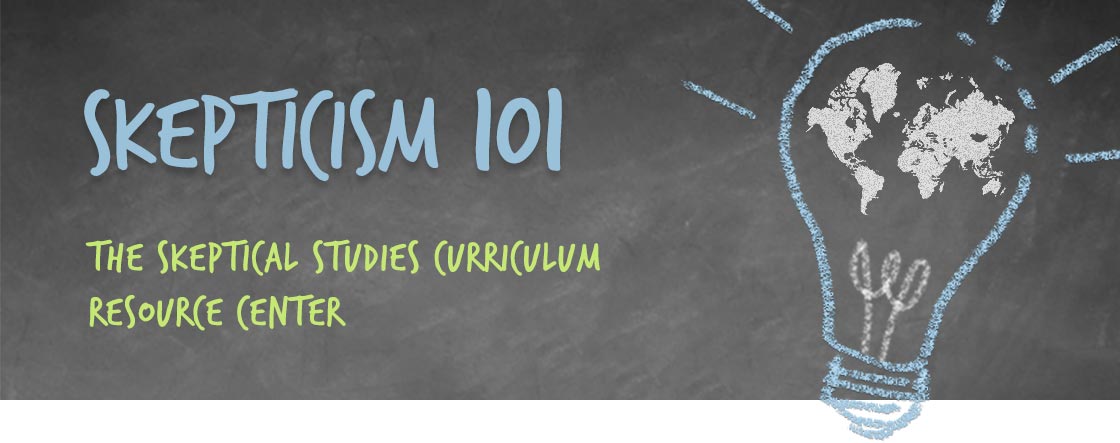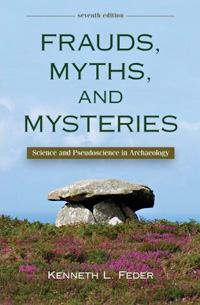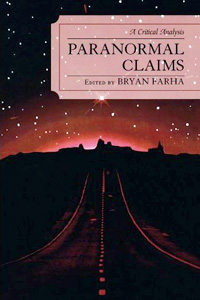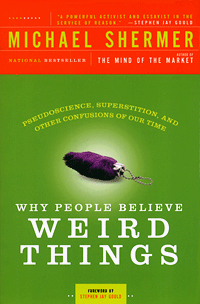You Are Browsing Resources
for the Academic Discipline of:
sociology and/or anthropology
This course was taught at Chapman University during the spring 2013 semester as an undergraduate course.
Excerpt from Syllabus
This course addresses the evolutionary origins of morality, the developmental psychology of moral emotions, the historical course of moral development throughout the history of civilization, and the forces that have bent the arc of the moral universe toward truth, justice, freedom, and prosperity.
Students will look at how the arc of the moral universe bends toward truth, justice, freedom, and prosperity thanks to science the type of thinking that involves reason, rationality, empiricism, and skepticism. The Scientific Revolution led by Copernicus, Galileo, and Newton was so world-changing that thinkers in other fields consciously aimed at revolutionizing the social, political, and economic worlds using the same methods of science. This led to the Age of Reason and the Enlightenment, which in turn created the modern secular world of democracies, rights, justice, and liberty.
DOWNLOAD THIS RESOURCE
(209 kb PDF)
This course was taught at the University of Texas at El Paso during the spring 2013 semester.
Excerpt from Syllabus
This course is designed to introduce students to a variety of critical thinking skills and to encourage them to practice those skills in the context of evaluating popular claims, especially extraordinary claims about topics relevant to anthropology and archeology. It is intended for students who are attracted to the interesting topics identified with anthropology in the popular media, but the level of instruction assumes no prior experience in anthropology. Students will learn about the methods used to interpret the physical traces of behavior, and how to distinguish scientific arguments from pseudoscience and non-science. Lectures, readings and class exercises will examine a variety of non-scientific explanations for past and present events, such as UFOs and ancient astronauts, Bigfoot, pyramid power, Atlantis, creationism and intelligent design, the Book of Mormon, dowsing, climate change denial, and psychic archeology.
Does Bigfoot roam the mountains of Oregon, and do his cousins hang out in the Sacramento Mountains of southern New Mexico? Are they shape-shifters, or do they use wormholes to travel the time-space continuum? Are extraterrestrial aliens like the ones who crashed in Roswell, New Mexico silvers or greens? Is there really an exotic blood-sucking animal called chupacabra killing livestock in the southern U.S. and northern Mexico, or is it just a hairless raccoon? Should we believe Senator James Inhofe when he says that global climate change is a hoax? Is cell phone use harmful to your health? Do the Power Balance bracelets worn by Drew Brees and Kobe Bryant provide any real scientific advantage to athletes? Are modern humans related to ancient prehistoric peoples, or were we created in modern form? Is there reliable evidence to support the claims that psychics can reveal details about the past or make valid predictions about the future? Was planet earth really visited by ancient astronauts, and did they teach Egyptians how to build the pyramids? How can we know the answers to such questions? In fact, how can we know the truth about any claim? We are bombarded by information and claims all the time, and it is vitally important, now more than ever, that we be able to distinguish valid information and warranted conclusions from those that are not. How can we do this, especially when the claims involve events that occurred in the prehistoric past, were not witnessed by humans, or were not documented in written records?
DOWNLOAD THIS RESOURCE
(4 MB PDF)
This book was required reading for Jeffrey Behm’s course, “Fantastic Archaeology” taught at the University of Wisconsin, Oshkosh during the fall 2010 semester.
Committed to the scientific investigation of human antiquity, this indispensable supplementary text uses interesting archaeological hoaxes, myths, and mysteries to show how we can truly know things about the past through science.
Examples of fantastic findings support the carefully, logically, and entertainingly described flaws in the purported evidence. By placing wildly inaccurate claims within the context of the scientific method, Frauds, Myths, and Mysteries demonstrates how science approaches fascinating questions about human antiquity and, in so doing, shows where pseudoscience falls short. —Amazon
BUY THIS BOOK
from Amazon
The presentation explores the evolutionary basis for the creation and consumption of art in all forms. It discusses art’s adaptive function; as well as, its role in natural and sexual selection. The universality and evolutionary basis of aesthetic tastes in art is also discussed. This presentation was created by Amanda Limongi for Dr. Michael Shermer’s course, “Evolution, Economics & the Brain” taught at Claremont Graduate University during the spring 2012 semester.
DOWNLOAD THIS RESOURCE
(6.6 MB Powerpoint Presentation)
This book was required reading for Dr. Bryan Farha’s course, “Sociology of Belief” taught at Oklahoma City University during spring 2011.
Published in April of 2007, this academic text features articles regarding paranormal, extraordinary, or fringe-science claims. It logically examines the claims of astrology; psychic ability; alternative medicine and health claims; after-death communication; cryptozoology; and faith healing, all from a skeptical perspective. Paranormal Claims is a compilation of some of the most eye-opening articles about pseudoscience and extraordinary claims that often reveal logical, scientific explanations, or an outright scam. These articles, steeped in skepticism, teach critical thinking when approaching courses in psychology, sociology, philosophy, education, or science. —Amazon
BUY THIS BOOK
from Amazon
This book was required reading for the following courses: (1) “Skepticism 101: How to Think Like a Scientist Without Being a Geek” taught by Michael Shermer, (2) “Weird Science” taught by John Donovan, and (3) “Skepticism, Science, & the Paranormal” taught by Martin Bridgstock.
In this age of scientific enlightenment, many people still believe in mind reading, past-life regression theory, New Age hokum, and alien abduction. A no-holds-barred assault on popular superstitions and prejudices, Why People Believe Weird Things debunks these nonsensical claims and explores the very human reasons people find otherworldly phenomena, conspiracy theories, and cults so appealing. Michael Shermer takes on science luminaries like physicist Frank Tippler and others, who hide their spiritual beliefs behind the trappings of science.
Shermer, science historian and true crusader, also reveals the more dangerous side of such illogical thinking, including Holocaust denial, the recovered-memory movement, the satanic ritual abuse scare, and other modern crazes. Why People Believe Weird Things is an eye-opening resource for the most gullible among us and those who want to protect them.
BUY THIS BOOK
from Shop Skeptic
This PowerPoint is part of a course titled, “Perspectives on Atheism.”
This presentation introduces the “Social Perspectives” segment of the course. JFK’s remarks on the separation of Church and State to the Houston Ministerial Association in 1960 are addressed in the context of Rick Santorum’s criticism. Sean Faircloth’s book, Attack of the Theocrats, is previewed. The question “Is America a Christian Nation?” is addressed before examining the phenomenon of Christian Nationalism. The American Constitution as a document expressing Enlightenment principles is examined. Recent rulings of the Texas School Board are used to illustrate the political effects of Christian Nationalism. The presentation concludes with the lawsuit brought on behalf of Jessica Ahlquist as an inspiring illustration of defending secularism.
DOWNLOAD THIS RESOURCE
(99 MB Powerpoint Presentation)
This course was taught at Claremont Graduate University during the spring 2012 semester.
Excerpt from Syllabus
Evolution, Economics, and the Brain is a doctoral-level Transdisciplinary Course designed to address large issues in which students employ knowledge and research protocols from many different disciplines to shed new light on specific problems. One of the books assigned—Steven Pinker’s The Better Angels of Our Nature—integrates evolution, history, anthropology, sociology, psychology, economics, and political science to explain a single phenomenon: the decline of violence. It is a model work in transdisciplinary integration.
A transdisciplinary and integrative overview of evolutionary theory, evolutionary economics, and neuroscience (“Evolution, Economics, and the Brain”) that includes a brief history and science of evolutionary theory, along with the evolution-creationism controversy and how it evolved in the context of American history and culture. As well, the application of evolutionary theory will be considered in its integration into psychology, anthropology, ethics, and economics. The course also includes an introduction to behavioral neuroscience and will focus on teaching students how new findings in the brain sciences can inform their work in the social sciences and humanities. For example: How reward acquisition is affected by risk; Why humans are typically risk-averse and when they are not; Hyperbolic discounting of future rewards; How interpersonal trust is built and maintained; How “rational” vs. “irrational” decisions are made; The basis for cooperation and aggression; The reason people punish others; The role of hormones in decisions; The basis for social norms or ethics; The sense of justice; The basis for love and hate and how these effect decisions; War and peace; Human nature; The decline of violence; The humanitarian and rights movements; and more.
DOWNLOAD THIS RESOURCE
(338 kb PDF)
This PowerPoint is part of a course titled, “Perspectives on Atheism“.
This presentation introduces the “Personal Perspectives” segment of the course. It covers the typologies of apostasy based on the work of Sociology Professor Phil Zuckerman, before introducing “The Clergy Project.” The personal experiences of Dan Barker are discussed. Various psychological factors underlying conformity to religious belief are examined, including obedience to authority, social proof, and groupthink.
DOWNLOAD THIS RESOURCE
(77 MB Powerpoint Presentation)
This PowerPoint is part of a course titled, “Perspectives on Atheism“.
This presentation draws on the work of Dale McGowan, and addresses the following topics: (1) Prevalent cultural attitudes towards atheists; (2) Our evolved tendency towards moral behavior; (3) The campaign against labeling children; (4) McGowan’s “Seven Secular Values”; (5) The Purpose Driven Life; (6) Addressing Death with Children; (7) Creative Secular Rituals; and (8) McGowan’s “Best Practices” for raising freethinkers.
DOWNLOAD THIS RESOURCE
(101 MB Powerpoint Presentation)
This PowerPoint is part of a course titled, “Perspectives on Atheism“.
This presentation introduces the “Ethical Perspectives” segment of the course. Based largely on the work of Sikivu Hutchinson, the following topics are addressed: (1) Racism in America using high profile contemporary examples; (2) Black religiosity; (3) The Black Church as a historically important safe harbor from racism; (4) Gender Politics—why African-American women are disproportionately religious; and (5) A brief historical overview of Black Freethought and Secular Humanism.
DOWNLOAD THIS RESOURCE
(110 MB Powerpoint Presentation)
This PowerPoint is part of a course titled, “Perspectives on Atheism“.
This presentation opens with criticism of the Catholic Church in popular narratives, before a discussion of the televised IQ2 Debate—“Motion: The Catholic Church is a force for good in the world.” Based largely on the work of English Historian, David Ranan, three historical landmarks of Church power are examined, including (1) The Trial of Galileo (Inquisition); (2) The Holocaust (Anti-Semitism); and (3) The Child Abuse Scandal. The presentation concludes by addressing the recent political activism of the Catholic Church opposing same-sex marriage and contraception.
DOWNLOAD THIS RESOURCE
(143 MB Powerpoint Presentation)
This PowerPoint is part of a course titled, “Perspectives on Atheism“.
This presentation introduces the “Critical Perspectives” segment of the course. Basic standards for objectively evaluating evidence are discussed, before introducing the Baylor Four-God typology based on US regional differences. The work of Karen Armstrong is used to discuss how concepts of God evolved into patriarchal monotheisms, marginalizing female divinities. Dan Dennett’s concept of “Belief in Belief” is introduced before addressing Richard Carrier’s four proofs justifying why he is not a Christian. The presentation concludes with the Epicurean refutation of God and a refutation of the Kalam Cosmological Argument.
DOWNLOAD THIS RESOURCE
(77 MB Powerpoint Presentation)
This PowerPoint is part of a course titled, “Perspectives on Atheism“.
This presentation introduces the rhetorical/cultural approach to studying Atheism. Two rationales for the course are provided: (1) Aligns with the critical thinking and truth seeking mission of the University; and (2) Provides students with an opportunity for personal understanding and clarifying values. A way of discreetly disclosing the identity of the Instructor as an Atheist, Tea Pot Agnostic, Freethinker, and Humanist is given. The presentation concludes by providing an overview of the course organization and a preview of topics.
DOWNLOAD THIS RESOURCE
(107 MB Powerpoint Presentation)
This PowerPoint is part of a course titled, “Perspectives on Atheism“.
This presentation examines four interrelated topics: (1) The Secularization Thesis; (2) Religious decline in the United Kingdom; (3) The American anomaly (why the United States is anomalously religious compared to other western countries); and (4) Religious decline in the US.
DOWNLOAD THIS RESOURCE
(147 MB Powerpoint Presentation)
This PowerPoint is part of a course titled, “Perspectives on Atheism“.
This presentation begins by correlating high levels of religious belief with high levels of scientific illiteracy in the United States. Based largely on J. Anderson Thomson’s book, Why We Believe in Gods, this presentation looks at the ways in which religious belief piggybacks on cognitive functions evolved for satisfying other purposes (social cognition) using examples from Thomson’s book.
DOWNLOAD THIS RESOURCE
(85 MB Powerpoint Presentation)
This PowerPoint presentation emphasizes the need to counteract false stereotypes about atheists and provides reasons why atheists and liberal religious persons should work together for the common-good. It contains demographics of religion and unbelief in America and encourages religious persons to reevaluate how they understand atheism. This PowerPoint was used for an in-class presentation (in TEDTalk format) to promote inter-faith and atheist dialogue. This presentation was created by Kile Jones for Dr. Michael Shermer’s course, “Evolution, Economics & the Brain” taught at Claremont Graduate University during the spring 2012 semester.
DOWNLOAD THIS RESOURCE
(1.8 MB Powerpoint Presentation)
In this lecture, arguably his most controversial subject that is based on his highly-acclaimed book, “How We Believe”, Dr. Shermer addresses a very old question in religion with the newest data from science, namely: why do people believe in God?
As Dr. Shermer attempts to answer the question using the best theories and data from anthropology, psychology, sociology, and evolutionary biology, Dr. Shermer also addresses the important role of religion in society, the historical roots of religion and why it arose around 5000 years ago as a co-equal partner to governments and states, the origin of myths and the importance of myth-making in human cultures, and what belief in God means for individuals and society. In his always conciliatory and friendly approach to deep and controversial subjects, Dr. Shermer nevertheless is not afraid to face head-on, and courageously confront our most meaningful questions that we all have about God, the universe, and the meaning of life.
DOWNLOAD THIS RESOURCE
(28 MB Powerpoint Presentation)
This course was taught at the University of Wisconsin, Oshkosh during the fall 2010 semester.
Excerpt from Syllabus
In its broadest sense, Fantastic Archaeology describes those claims and interpretations about the archaeological record that are outside the orthodox mainstream of the scholarly and professional world of archaeology. This can range from new, as yet untested hypotheses that may become the orthodox interpretations to the outrageous claims that can be easily refuted. Students will examine this entire range of competing, non-orthodox interpretations of the archaeological record.
This course has a much broader subject area than students are likely to encounter in other courses–even in an eclectic field like Anthropology. Students have the opportunity to bring knowledge and expertise acquired in other courses, or their general life experience, to the discussions.
DOWNLOAD THIS RESOURCE
(630 kb PDF)
This course was taught at Oklahoma City University during the spring 2011 semester.
Excerpt from Syllabus
This critical thinking course interprets extraordinary claims using reason, logic, and skeptical analysis in drawing conclusions. Fringe science, pseudoscientific, and bogus health claims will be evaluated based on available evidence. Health claims, fortune- telling (astrology, psychic predictions, palm reading), alternative medicine, sensory illusions such as magic, faith healing, clairvoyance, telepathy, the lunar effect, and psycho-kinesis will be some of the topics likely covered. The role of the media in covering and reporting such claims will be explored. The course will focus on drawing plausible and logical conclusions based on evaluation of existing evidence. Assignments will include weekly quizzes, class discussions, and a formal project/presentation.
Learning Goals
- Have a basic knowledge of critical thinking, skeptical thought, and the scientific method.
- Discriminate between sound vs. faulty logic in descriptions and observations of pseudoscientific claims.
- Demonstrate how to conduct research and/or investigate anomalistic phenomena via a positive working relationship with a team of students.
- Evaluate skeptical knowledge of unexplained phenomena, its claim(s), or a central skeptical figure.
DOWNLOAD THIS RESOURCE
(194 kb PDF)
NEXT PAGE →












